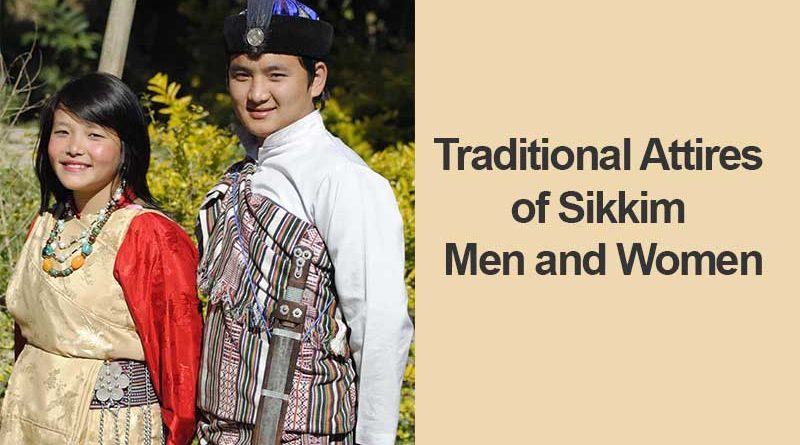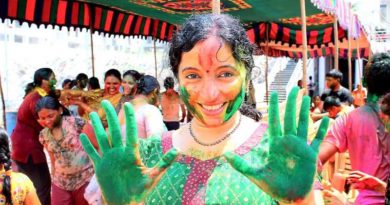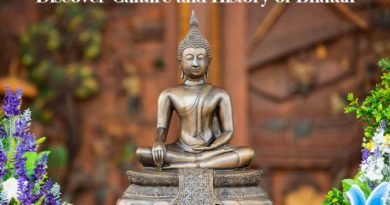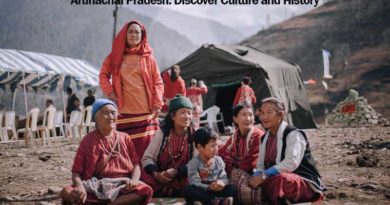All You Need to Know About Traditional Dresses of Sikkim
In modern times, Sikkim is an Indian state that is multiethnic and multilingual. It is a tiny state in India located in the northeastern Himalayas, sharing borders with Nepal in the west, Bhutan in the east, and China in the northeast.
It is noted for its magnificent beauty, crystalline lakes, tasty cuisine, colorful clothes, a rich and captivating culture, and, of course, gorgeous dance forms!
This kingdom of mountains has its own identity as being the gateway to the Himalayas. You will be delighted by the state’s fascinating locations and observe how Hinduism and Buddhism coexist in Sikkim, resulting in Sikkim’s special and peaceful culture.
Just like any other place, people can be described and recognized by the clothing and jewelry they wear. You will come across a diverse population if you spend your vacation in Sikkim.
Importance of Cultural Dresses in Sikkim
People from all around the world adhere to their customs to the fullest, and their outfits show integrity and history. Cultural clothes are extremely significant to Sikkimese people because they provide a particular cultural and traditional appeal that distinguishes oneself from the crowd. If the value of these garments is lost, culture will suffer.
Only the elite class wore traditional attire during the “Namgyal dynasty,” as it imparted class and dignity to the towns. Sikkim people now dress in cultural costumes that show their culture, customs, unity, and history.
Sikkim’s traditional attire also reveals their marital, social, and religious identity. In all of Sikkim’s communities, men and women wear distinct ethnic attire.
Here’s everything you need to know about the Sikkim traditional attire that they wear. Let’s look at the many Sikkim traditional costumes that are prevalent amongst people.
Traditional Attires of Sikkim
Bakhu
The Bakhu (in the Nepalese language), also known as Kho (in the Bhutia language), is the traditional Sikkim dress.
Bakhu is a sleeveless version of the Tibetan Chuba, which is worn by both men and women. You can think of it as a cloak-like garment with a silk or cotton belt that you have to tighten near the waist and then tie at the neck.
As western culture’s influence has risen in the country, ladies have begun to match it with a pair of jeans to give a traditional look a western twist. You can also wear it with shawls, known as Majetro, and elegant blouse patterns like Chaubandi Cholo and Tharo Cholo.
Dumvum
Lepcha women wear a cloth called Dumvum or Dumyam, resembling a saree, as part of their traditional dress. It’s a silky, smooth ankle-length dress, along with a loose, contrasting-color blouse known as Tago. It is worn underneath.
A Nyamrek and Taro belt, as well as a cap, are worn to complete the outfit. The head is frequently covered with a Gorey scarf. It enhances a woman’s beauty and symbolizes her honor and pride.
The attire of Lepcha women and men differs in an unusual way. The Thokro-Dum’s calf-length bottom suggests they live in the marshy territory, but the flowy Dumvum shows they live in the dry territory.
The male costume is rough, designed for the rough nature of their work in rough terrains. On the other hand, the female costume is constructed of a gentle and lighter cloth to give it feminine touch.
Thokro-Dum
For people of the Lepcha community, Thokro-Dum attire is the most important piece of clothing. This is typically worn by Lepcha bread bakers.
It’s made up of a white pajama that reaches near the calves. It’s matched with a Lepcha shirt called Yenthatse and an embroidered headgear called Shambo.
They also wear bamboo and rattan hats in the shape of cones at weddings and other important occasions such as religious and festive gatherings. Fine bamboo canes, straws, and leaves are used to make these hats.
These hats are called Thyaktuk, and their variants are finely woven headgear with great historical and real roots. During the Chogyal dynasty’s reign, royal soldiers used like as a traditional headpiece too.
To complete the look, a hand-woven waistband called Dupra is pinned at one of the shoulders and then wrapped around the waist.
The men’s Pajama has a special value for the tribe because of their short length. It implies that the males are natives of swampy places. The material’s texture is rough and durable, making it ideal for a long day in the field.
Shuruval
This attire is worn by Nepalese males in Sikkim. They wear this as an ode to their tradition that is both stylish and comfortable.
A trouser is worn with a long double-breasted coat that reaches a little below the waist. Shuruval is the name of the bottom, and Daura is the name of the shirt.
The Shuruval is complemented by a waistcoat, Askot, and a belt, Patuki. They also have the Khukri; a hefty weapon placed in a leather case (Daab).
Dum Praa
The Lepcha tribe’s male outfit has a special design to assist males with their regular field chores. They’ve been designed with the tough nature of men’s work in the fields and forests in mind.
The men of the Lepcha tribe wear “Dum Praa,” which is made up of the patterns as below:
- Tagaap: Dum Praa’s oldest design is Tagaap! It has flowery motifs and designs.
- Khemchu: Scissors patterns can be found in the style, Khemchu.
- Tamblyoak: This Sikkim traditional garment style, called Tamblyoak, features butterfly designs.
Pharia
The traditional dress known as Pharia, which enhances the beauty of Nepalese women, comes in a range of colors.
The Bhutias wear a long, comfortable-fit shirt that is knotted on four sides. Hence, it is known as Chaubandi Cholo. The upper body is neatly covered in a piece of cloth known as Hembari available in stunning designs for added coverage.
They also wear Majetro shawls. Nepalese ladies dance with a colorful fabric suspended from their head to waist in addition to the Pharia, called Pachauri.
Wedding Attire
Traditional wedding attire is incredibly vibrant and wonderful to look at no matter where you go.
Similarly, when it comes to the Eastern part of the Himalayas, the bride and groom are dressed royally in the finest clothes.
The bride is dressed by the traditionally rich Bakhu created from the best silks. The groom wears an outfit with a similar style. Baggy trousers are the only distinguishing feature of the attire.
Leather boots are worn by both men and women. This makes the outfit look more elegance. When it comes to jewelry, the best type of gold is taken.
Cultural Ornaments of Sikkim
All of Sikkim’s cultures have gleaming ornaments made primarily of gold and silver, but bangles made of seven metals are a particularly popular item. Chains, bracelets, finger rings, and other ornaments in Sikkimese use precious and semi-precious stones.
Women are mostly seen wearing traditional jewelry with their cultural clothing at festivals and weddings.
Tradition, culture, history, and, most importantly, beauty are all represented through the clothing and jewels worn.
The three tribes each have their own style of jewelry, which are as follows:
- Lepchas
Women can be seen wearing traditional jewelry such as the Lyak (necklace), Namchok (ear-ring), and Gyar (necklace) at festivals and other occasions (bracelet). The most common metals utilized in their creation are silver and gold.
- Bhutias
Bhutia women wear Yencho (earring), Khalli (thick silver-coated anklets), and Joko (ring), Khao (necklace), Phiru (pearl ornament), and Diu (gold bangle), . They are well-known for their fondness for gold, particularly genuine 24-carat gold. Pure, massive gold jewelry is their preferred choice.
- Nepalese Ornaments
Sir-Bandi (tiara), a jeweled head-ornament, Kantha (necklace), Naugeri (pearl necklace), and Charanihari, yet another necklace, are the ornaments that give Nepalese ladies a lovely appearance.
Here’s a article that explains all about the Traditional Jewelry of Sikkim
When Do Sikkimese People Wear Traditional Dresses?
Styles and fashion have progressed over time, but there are still traces of the past. Sikkim is home to a diverse range of ethnic groups, and a variety of festivals are lavishly held throughout the year, with locals displaying their cultural attire in vibrant colors.
Phang lhabsol, Saga Dawa, Dasain, Dipawali, and Loosong are the most important festivals. Weddings are another occasion where people don their traditional or cultural attire.
It is believed that traditional or cultural attire strengthens the culture’s essence and origins, which unites the people together. All of Sikkim’s brides and grooms dress lavishly for their weddings, and when it comes to embellishing their wedding outfits, both couples choose the purest form of gold, displaying simplicity and grace.
Apart from weddings and festivals, there are other tourism festivals held throughout the state to promote tourism, and at these events, you can see many people dressed in traditional attire and dancing to traditional music.
Changes In Sikkim Dresses Over The Years
Bakhu, a traditional Sikkim dress, is worn by both men and women and is combined with cotton or silk belts and leather boots.
However, new additions to Sikkim’s traditional attire have emerged as fashion trends have altered. Along with the Sikkim traditional dress, communities have begun to wear a waistcoat known as Jya Jya, a shambo (an embroidered headgear), and a jacket known as Kushen.
The overall traditional aspect of Sikkim has become more graceful and attractive as a result of these new updates.
Shopping for Traditional Dresses in Sikkim
Sikkim is one of those areas where fantastic shopping opportunities attract visitors. There are many things to buy in Sikkim like wall hangings, prayer flags, Thangkas, Chooses, woolen carpets, Chosees, tea, Sikkim’s traditional attire, and pickles.
For tourists visiting Sikkim, MG Road in Gangtok is the main retail area. This long street is surrounded on both sides by a variety of stores that cater to practically every tourist need! On Tuesdays, the market is closed.
MG Road Gangtok has a huge selection of men’s and women’s clothing, as well as souvenirs, presents, trinkets, shoes, accessories, and home decor.
You should look over the Sikkimese cultural clothing when exploring the Sikkim cloth markets. The materials and styles of these gowns are sure to tempt you to purchase one. This could be a valuable souvenir you bring back from your trip to Sikkim.
Turquoise stone jewelry and blue stone jewelry are two popular Himalayan jewelry designs that everyone wishes to own. Traditional designs may catch your interest the most.
Traditional jewelry such as Ghau pendants and Akor earrings are popular. Ghau pendants are elaborate boxes in which prayer scrolls can be kept, and Akor earrings, which are lengthy, are commonly worn by Lhasa ladies.
The Old Market in Sikkim is another place to go shopping for clothes. It is one of Sikkim’s busiest retail districts. Old Market, on MG Marg, is known for its trendy clothes and accessories.
The dominant tone of tourists bargaining for a good price fills the Old Market at all times. Make sure to look at the Dogra jewelry and handicrafts available for purchase.
It is highly recommended that you bring some additional bags with you since as you enter the markets of Sikkim, all you would think about is “I should take some from each of these, as well as everything else.” And no matter how much space you have in your suitcase, it will not be enough for you. As a result, you must exhibit self-control while buying.
Final Thoughts
The Sikkimese clothing and jewelry are a great blend of culture, diversity, contentment, and, of course, elegance. They are a wonderful match for the earthiness and peacefulness that pervade Sikkim’s environment. If you happen to be in Sikkim, you should definitely try them on. Then and only then can the culture fully be felt.
So there you have it: the various forms of Sikkim traditional attire for men and women. We hope that a few traditional clothes aroused your interest and tempted you to shop in Sikkim for these on your next visit!
There are several tourist attractions in Sikkim, such as the Bakthang waterfalls and Hanuman Tok, where you may try on traditional clothing and take a photo to cherish. If you ever find yourself in Sikkim, make sure to give it a try.



